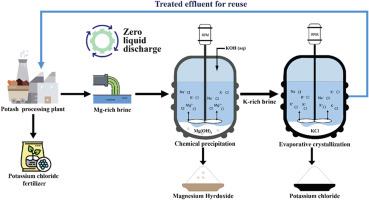钾盐废水的资源回收:综合化学沉淀和蒸发结晶,实现零液体排放和可持续盐水管理
IF 8.1
2区 环境科学与生态学
Q1 ENVIRONMENTAL SCIENCES
引用次数: 0
摘要
光卤石加工产生的钾盐卤水废水(PBE)的增值为解决钾肥开采行业的环境和经济挑战提供了一个变革性的机会。提出了一种结合化学沉淀和蒸发结晶的新型湿法冶金方法,从PBE中回收高纯氢氧化镁(Mg(OH)2)和氯化钾(KCl),实现了零液体排放。通过响应面法(RSM)对氢氧化钾(KOH)化学沉淀镁进行了优化,在最佳条件(2.4 mol/L KOH, 60°C, 40 min)下,Mg(OH)2的回收率为88%,纯度为95%。随后的富钾流蒸发结晶生产纯度为99.15%的氯化钾晶体,符合商业肥料标准。该工艺利用了基本的水化学原理,包括pH控制、过饱和驱动成核和选择性结晶,以最大限度地提高资源效率。通过XRD、SEM-EDS、TGA等综合表征,证实了回收产物的结构和组成质量。通过将PBE转化为可销售的商品,这一综合战略不仅减轻了与卤水处理相关的环境风险,而且还为钾肥行业建立了循环经济框架。该混合工艺可实现高纯度Mg(OH)2(95%)和KCl(99.15%)的回收,实现了零液体排放(ZLD)的目标。该方法为矿物加工中的可持续卤水管理提供了基础。本文章由计算机程序翻译,如有差异,请以英文原文为准。

Resource recovery from potash brine effluent: integrated chemical precipitation and evaporative crystallization for zero liquid discharge and sustainable brine management
The valorization of potash brine effluent (PBE) from carnallite processing offers a transformative opportunity to address environmental and economic challenges in the potash mining industry. This study presents a novel hydrometallurgical approach integrating chemical precipitation and evaporative crystallization to recover high-purity magnesium hydroxide (Mg(OH)2) and potassium chloride (KCl) from PBE, achieving zero liquid discharge (ZLD). Chemical precipitation of magnesium using potassium hydroxide (KOH) was optimized via response surface methodology (RSM), achieving 88 % Mg recovery as Mg(OH)2 with 95 % purity under optimal conditions (2.4 mol/L KOH, 60 °C, 40 min). Subsequent evaporative crystallization of the potassium-rich stream produced KCl crystals with 99.15 % purity, meeting commercial fertilizer standards. The process leverages fundamental aqueous chemistry principles, including pH control, supersaturation-driven nucleation, and selective crystallization, to maximize resource efficiency. Comprehensive characterization using XRD, SEM-EDS, and TGA confirmed the structural and compositional quality of the recovered products. By transforming PBE into marketable commodities, this integrated strategy not only mitigates environmental risks associated with brine disposal but also establishes a circular economy framework for the potash sector. The hybrid process achieves high-purity Mg(OH)2 (95 %) and KCl (99.15 %) recovery from potash brine, fulfilling zero liquid discharge (ZLD) objectives. The methodology provides a foundation for sustainable brine management in mineral processing.
求助全文
通过发布文献求助,成功后即可免费获取论文全文。
去求助
来源期刊

Chemosphere
环境科学-环境科学
CiteScore
15.80
自引率
8.00%
发文量
4975
审稿时长
3.4 months
期刊介绍:
Chemosphere, being an international multidisciplinary journal, is dedicated to publishing original communications and review articles on chemicals in the environment. The scope covers a wide range of topics, including the identification, quantification, behavior, fate, toxicology, treatment, and remediation of chemicals in the bio-, hydro-, litho-, and atmosphere, ensuring the broad dissemination of research in this field.
 求助内容:
求助内容: 应助结果提醒方式:
应助结果提醒方式:


